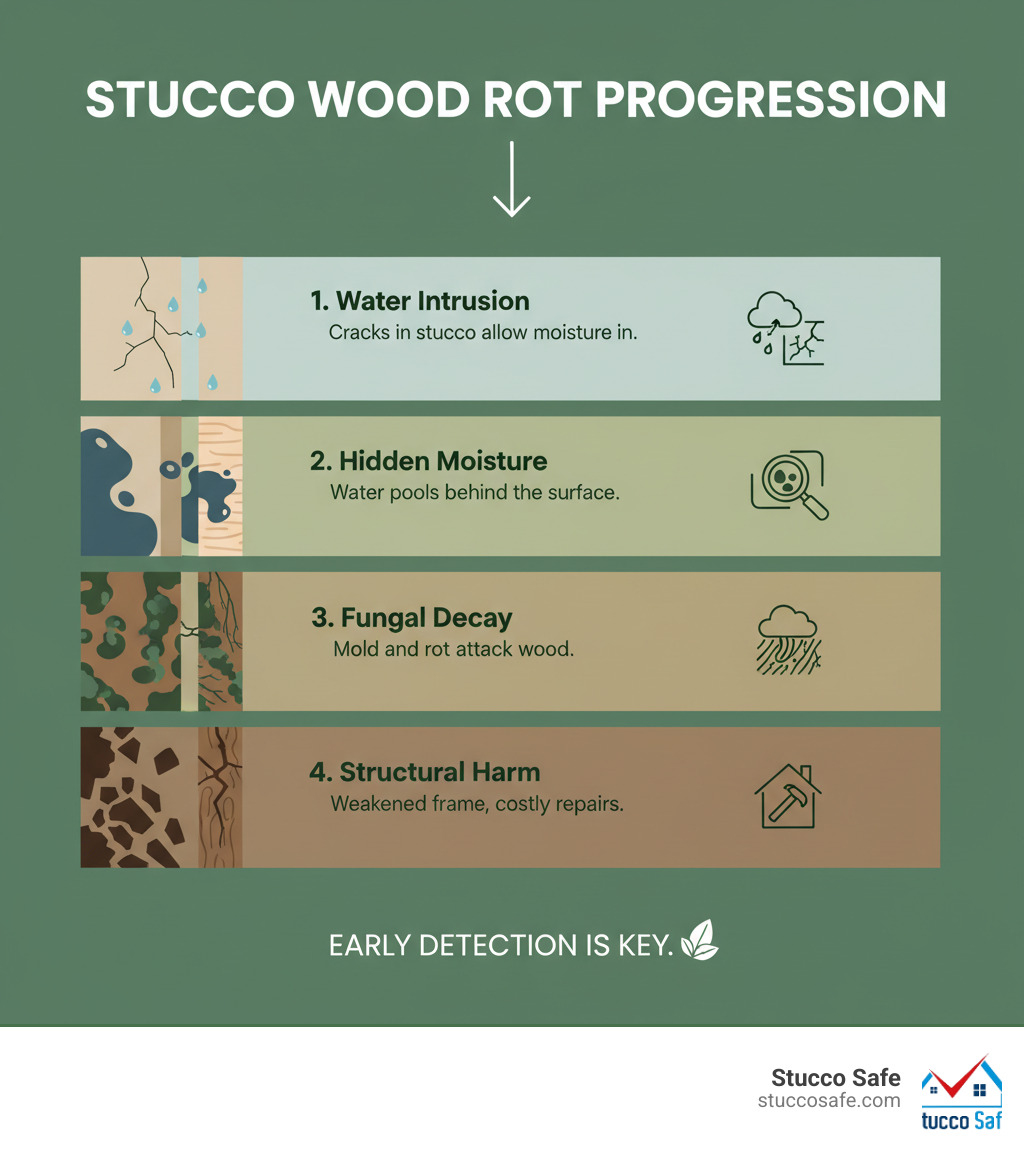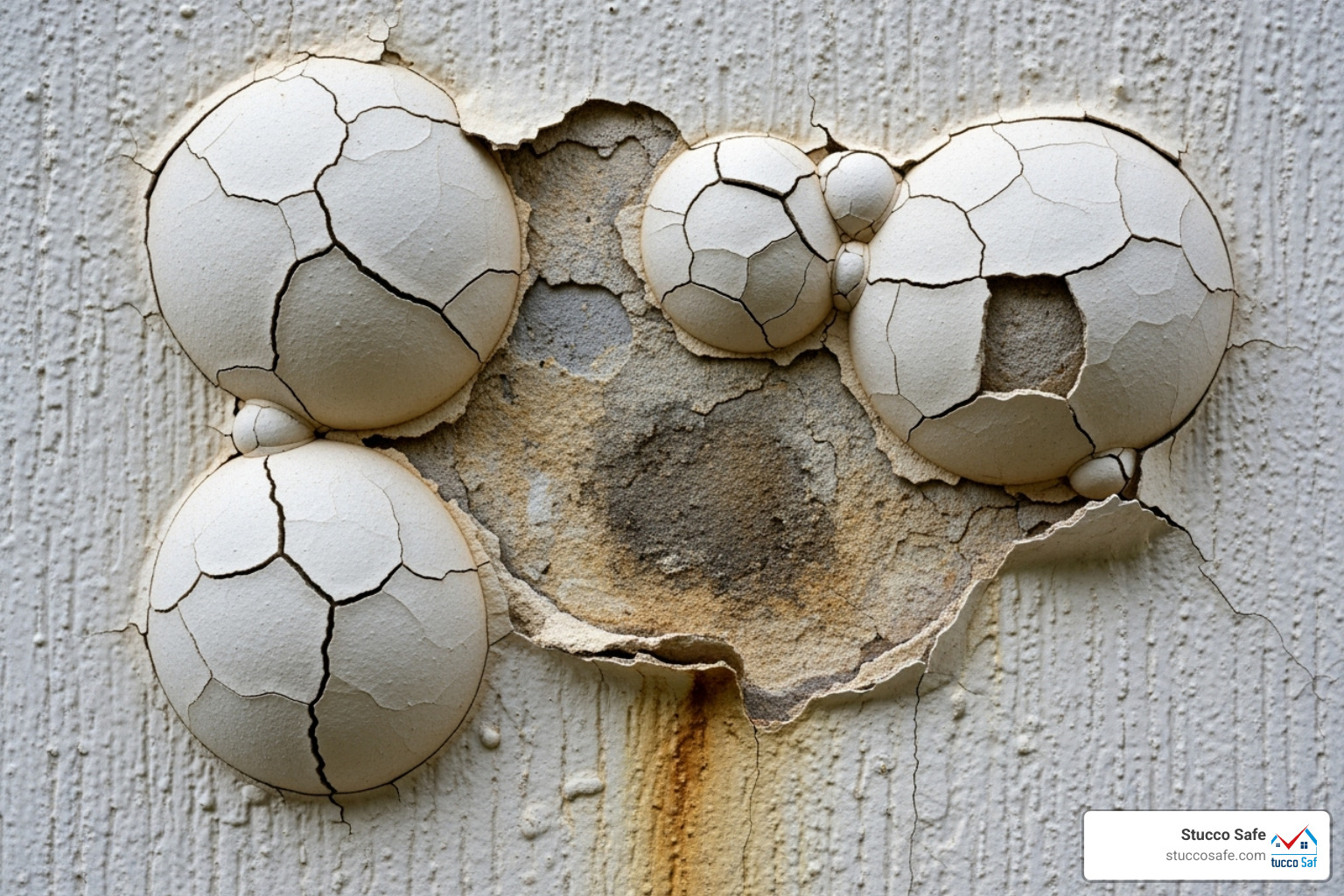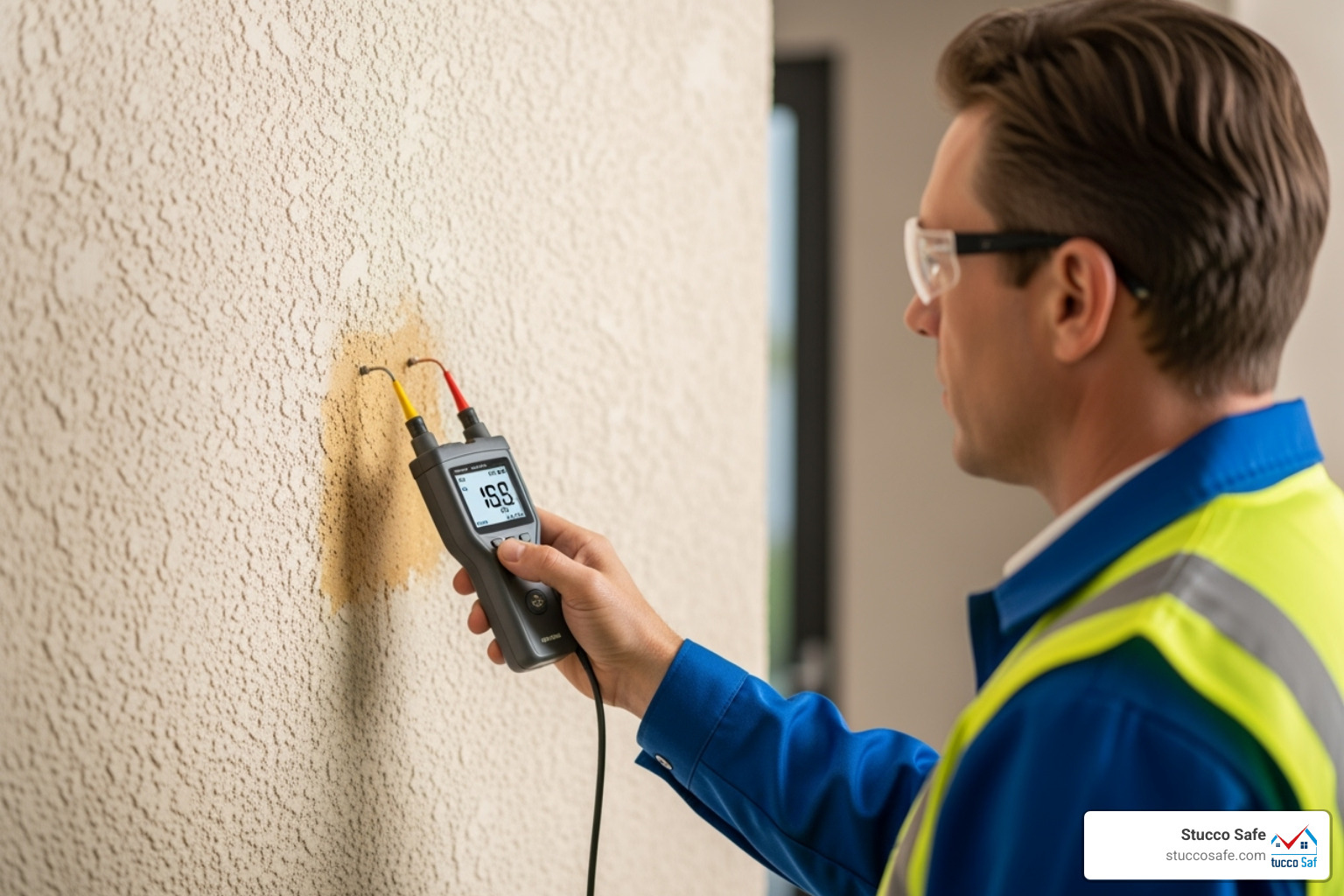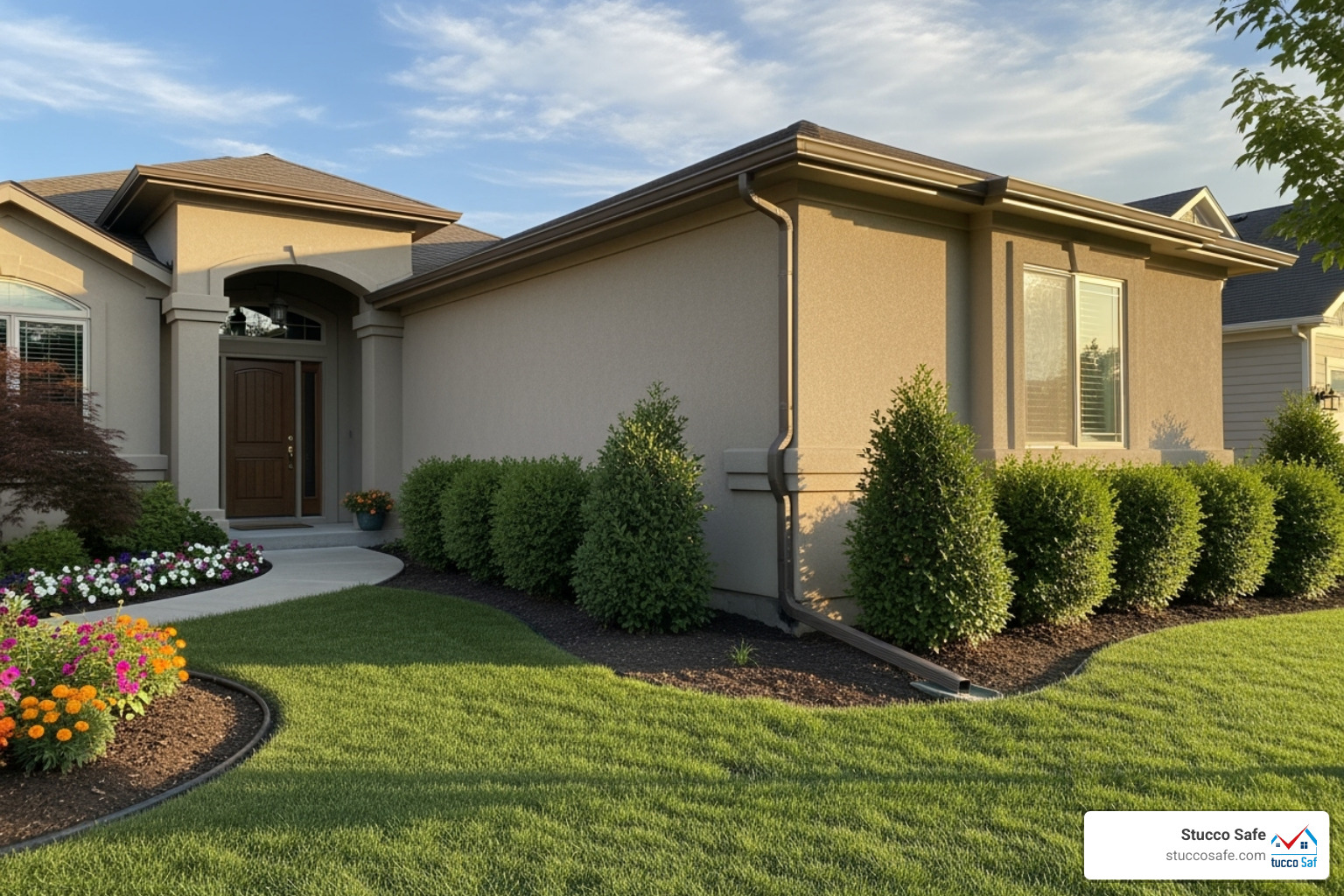Stucco Wood Rot: Uncover 2025’s Hidden Dangers
Why Stucco Wood Rot is a Silent Threat to Your Home
Stucco wood rot occurs when moisture penetrates behind stucco walls, creating the perfect environment for wood-destroying fungi to thrive. This hidden problem affects thousands of homes, especially those built between 1985 and 2003, and can lead to serious structural damage if left untreated.
Key Facts About Stucco Wood Rot:
- Primary cause: Moisture intrusion through cracks, failed caulking, or improper installation.
- Hidden nature: Damage occurs behind the stucco, invisible until advanced stages.
- Common signs: Soft spots, staining, musty odors, and interior paint peeling.
- High-risk homes: Properties built during incorrect building code periods (1993-2006 have up to 90% failure rates).
- Cost impact: Can require thousands of dollars in remediation when found late.
The challenge is that stucco itself is usually the last thing to show signs of failure. While your exterior walls may look solid, moisture can silently seep behind the coating, saturating the wood sheathing and framing. This creates ideal conditions for rot and mold, compromising your home’s structural integrity.
Many homeowners find this problem too late, often during a home sale inspection. The good news is that with proper detection and prompt action, stucco wood rot can be addressed before it becomes a major structural concern. As an EDI Level 2 Certified Stucco Inspector with over 20 years of experience, I’ve helped thousands of homeowners identify and resolve these issues before they become costly disasters.
The Root of the Problem: What Causes Dry Rot Behind Stucco?
The root cause of stucco wood rot is moisture. When water gets trapped behind stucco, it creates a breeding ground for fungi that devour your home’s wooden structure, turning solid beams into weak, crumbly material.
This isn’t just about a small leak. It’s a result of failed water management systems, outdated building codes, architectural flaws, or overlooked maintenance. Homes built between 1985 and 2003 are at a significantly higher risk, with some periods showing failure rates as high as 90%. Understanding these systemic issues is the first step toward prevention. Our guide on What are the Problems with Stucco Houses? and our resource on Moisture Intrusion Stucco explain these problems in detail.
How Moisture Becomes Trapped
Stucco is naturally porous and designed to breathe. Problems arise when moisture enters and cannot escape.
- Failed caulking around windows and doors is a common entry point. Sealants crack and shrink over time, creating pathways for water.
- Improper window and door flashing provides a direct route for water into your walls. Missing flashing can allow gallons of water to penetrate during a single storm.
- Roof-to-wall transitions handle large volumes of water. Without proper kick-out flashing, rainwater can pour directly into wall cavities.
- The lack of a weep screed at the base of walls prevents trapped moisture from draining out, causing it to accumulate.
- Even small cracks in the stucco surface can become major entry points for water. Learn more about how stucco interacts with water in our guide, Does Stucco Absorb Water?.
The Role of Improper Installation
Many stucco wood rot issues are built into the home from day one, often reflecting the building standards of the time.
- The incorrect building codes period (1985-2003) led to homes being constructed with inherent flaws in their water management systems.
- Missing or improperly installed moisture barriers are a serious defect. This barrier is the secondary line of defense; without it, water goes directly to the wood structure.
- Inadequate drainage planes mean that even with a moisture barrier, water has nowhere to go. It sits against the barrier and eventually finds a way through to the wood.
- Non-adherence to ASTM standards during installation can create weak points that invite moisture intrusion years later.
Understanding proper Moisture Barrier Stucco installation is crucial for protecting your home against the stucco wood rot it causes.
Recognizing the Telltale Warning Signs
Your home often gives clues when stucco wood rot is developing, but the signs can be subtle. This destructive process stays hidden for years, so knowing what to look for is key to catching it early. Think of it as detective work; the evidence is there if you connect the dots. Catching these signs early can prevent minor moisture issues from becoming major structural repairs. Our Ultimate Guide to Stucco Inspection shows how professionals approach this work.
Exterior Clues
While stucco is often the last part of the system to show distress, your home’s exterior provides important hints.
- Cracks and gaps are the most obvious entry points for water. Look carefully around windows, doors, and where stucco meets other materials. Pay special attention to failing caulk. Don’t ignore these issues; our guide on Bubbling Stucco: A Guide to Prevention and Repair explains why.
- Staining and discoloration, like dark streaks from windows or greenish patches near the foundation, are signs of water intrusion. These Stucco Water Stains are valuable early warnings.
- Soft or spongy spots are an alarming sign. If stucco feels soft when you press on it, the wood behind it is likely already rotting.
- Bubbling or peeling stucco occurs when trapped moisture pushes the stucco away from the wall, signaling a critical moisture problem.
Interior Red Flags
Sometimes the first signs of stucco wood rot appear inside your home.
- A persistent musty odor is often the first clue of hidden mold growth in your walls.
- Peeling paint or wallpaper on walls adjacent to the exterior stucco indicates moisture is seeping through from the outside.
- Damp drywall or unexplained water stains on interior walls or ceilings near stucco areas are clear signs of a leak.
- Unexplained increases in energy bills can occur when moisture compromises insulation, forcing your HVAC system to work harder.
Learning to recognize these warning signs can save you thousands of dollars and protect your family’s health.
The Hidden Dangers: Risks of Ignoring Stucco Wood Rot
When homeowners find stucco wood rot, they are often shocked by the extent of the damage behind a seemingly sound wall. Ignoring the warning signs is not just costly—it can be dangerous. A small moisture issue can escalate into a major structural crisis, threatening your family’s safety and your finances. Our guide on Is it a Risk to Buy a Stucco House? provides more insight into these concerns.
Structural and Financial Risks
The most alarming consequence of untreated stucco wood rot is the damage to your home’s structural integrity.
- Compromised wood framing and sheathing decay are the primary structural issues. Wood-destroying fungi consume the cellulose in your home’s studs and joists, turning solid lumber into a material resembling wet cardboard. The sheathing loses its strength, compromising the home’s ability to withstand wind and other forces.
- In severe cases, there is a potential for collapse. I’ve inspected homes where entire wall sections had lost their structural integrity, posing a genuine safety hazard.
- Financially, the impact is devastating. Decreased property value is almost certain, as buyers are wary of hidden structural problems.
- The costly repairs for advanced wood rot can easily reach tens of thousands of dollars. This involves full-scale remediation, as gradual moisture damage is typically excluded from standard homeowner’s insurance policies. While understanding How to Get Stucco Damage Covered by Homeowners Insurance can help, prevention is your best financial strategy.
Health Risks from Mold and Mildew
Beyond structural damage, stucco wood rot creates a breeding ground for mold and mildew, which can seriously impact your family’s health. The constant moisture trapped in wall cavities is a paradise for mold, and spores can enter your living space through tiny cracks and outlets.
- Respiratory issues like increased asthma symptoms, persistent coughing, or difficulty breathing are common, especially for children and the elderly.
- Allergies can flare up, causing sneezing, watery eyes, skin rashes, or persistent cold-like symptoms.
- Unpleasant musty odors are a clear warning sign of active fungal growth and an airborne health hazard.
If you suspect mold, investigate immediately. Our resources on How to Detect Mold in Your Home and professional Mold Inspection in Stucco Homes can help. Stucco wood rot doesn’t improve with time; delaying action allows fungi to continue destroying your home and compromising your family’s health.
From Detection to Resolution: A Homeowner’s Guide
Facing the threat of stucco wood rot can be overwhelming, but there is a clear path to a solution. The process involves professional detection, understanding the difference between repair and remediation, and executing the right fix. Our Stucco Home Inspection is the ideal first step to gain clarity.
How Professionals Detect Stucco Wood Rot
Detecting stucco wood rot requires more than a visual check, as the damage is hidden. We use forensic methods to uncover the truth.
- Our primary tool is the moisture meter with hammer probes. We use professional-grade meters to read moisture content deep within the wall structure by drilling small, easily patched 3/16-inch holes.
- If readings are high, we may recommend an Invasive Stucco Inspection, which involves removing a small section of stucco for visual confirmation of rot. Our Stucco Moisture Probe article explains this process.
- Note on thermal cameras: Infrared thermography is largely ineffective for finding deep, hidden moisture issues in stucco systems.
- The most crucial part of detection is identifying the water’s entry point. We examine flashings, sealants, and other details to find the source of the problem, ensuring a permanent fix.
Stucco Repair vs. Stucco Remediation
Understanding the difference between repair and remediation is critical to choosing the right solution.
- Stucco repair is a cosmetic, temporary fix. It involves patching cracks or small damaged areas. If you have underlying stucco wood rot, repair is just a band-aid that masks the real problem.
- Stucco remediation is a comprehensive solution. It means removing damaged materials, replacing rotted wood, and installing a proper water management system. It’s a larger investment but the only way to truly solve the problem.
Essentially, repair addresses symptoms, while remediation fixes the root cause. Our Stucco Moisture Remediation process ensures the problem doesn’t return.
Steps to Repairing Stucco Wood Rot
When stucco wood rot is confirmed, remediation is necessary. This is a complex job for skilled professionals.
- Exposing the damage: We remove the exterior stucco and sheathing to reveal the full extent of the rot.
- Removing rotted wood: All compromised framing, sheathing, and insulation must be removed completely.
- Replacing framing and sheathing: We use new, treated lumber to restore the home’s structural integrity.
- Installing a new water management system: This is the most critical step and includes a water-resistant barrier, new flashing, weep screeds, and drainage mats.
- Re-applying stucco: Professionals apply new stucco, matching the texture and color for a seamless finish.
While our How to Repair Stucco guide covers minor issues, stucco wood rot demands expert intervention.
Prevention is Key: Safeguarding Your Home
The saying “an ounce of prevention is worth a pound of cure” is especially true for stucco wood rot. Proactive maintenance is far less costly and stressful than extensive remediation. Your stucco home requires regular attention to remain in good condition. Most preventive measures are straightforward and can be handled by any homeowner. For a complete overview, see our guide on Does Stucco Exterior Require Maintenance?.
Routine Maintenance Checklist
Preventing stucco wood rot starts with a simple maintenance routine.
- Bi-annual visual inspections: Walk around your home in spring and fall. Look for new cracks, staining, or gaps in caulking, especially after severe weather.
- Sealing cracks promptly: Even hairline cracks can let in significant moisture. Use a high-quality exterior sealant to address them immediately. Our guide on How to Repair Exterior Stucco Cracks shows you how.
- Cleaning gutters and downspouts: Ensure water flows away from your home, not down your stucco walls. Downspouts should direct water at least 5-10 feet from the foundation.
- Proper landscape grading: The ground should slope away from your foundation to prevent water from pooling against the walls.
- Checking sealant around windows and doors: Inspect caulking regularly and replace any that is cracked, shrinking, or missing.
The Importance of Professional Inspections
While homeowner maintenance is valuable, it can’t replace a professional’s trained eye.
- Catching issues early is the primary benefit. We use specialized moisture meters to detect problems long before they are visible. Early detection can save you thousands in repair costs.
- Certified inspectors matter. Our EDI Level 2 Certified team has specialized training in stucco systems and moisture dynamics. This expertise is Why Hire a Separate Stucco Inspector? instead of relying on a generalist.
- Peace of mind from a professional inspection is invaluable. Knowing the true condition of your exterior walls allows you to make informed decisions.
A professional stucco inspection typically costs between $495 to $1595, a small price compared to the tens of thousands that remediation can cost. For more details, visit Stucco Inspection Costs: What to Expect. We proudly serve homeowners throughout Southeastern Pennsylvania, New Jersey, and Delaware, because prevention is the best medicine.
Conclusion
Stucco wood rot is a serious threat, silently damaging your home’s structure behind a seemingly sound exterior. It can compromise your home’s integrity, drain your finances, and even impact your family’s health.
The reality is that this problem thrives in silence. By the time visible signs appear, significant damage has often occurred, especially in homes built between 1985 and 2003 with inadequate moisture management systems.
However, stucco wood rot is both preventable and manageable with early action. Warning signs like exterior cracks, interior musty odors, or peeling paint are your home’s call for help. Responding promptly can be the difference between a minor repair and a major remediation project. Regular maintenance is key, but it should be paired with professional inspections that use specialized tools to find problems invisible to the naked eye.
The financial stakes are high. A professional inspection, costing $495 to $1595, is a small investment compared to remediation costs that can run into the tens of thousands. More importantly, early detection protects your family’s health and your home’s safety.
At Stucco Safe, we have over 20 years of experience helping homeowners protect their investments with expert forensic testing. Our EDI Level 2 certified inspectors serve Southeastern Pennsylvania, New Jersey, and Delaware, providing the expertise needed to address stucco wood rot before it becomes a crisis.
Don’t let a beautiful facade hide a devastating problem. For a comprehensive evaluation, schedule your professional stucco inspections in New Jersey or contact us for service in our other areas. Your home’s strength and your family’s safety depend on taking action before it’s too late.





